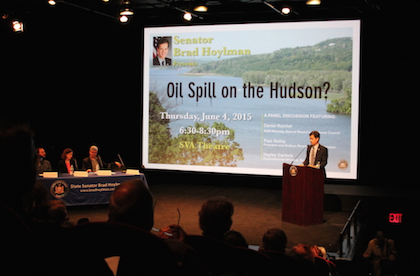
BY YANNIC RACK | The US Environmental Protection Agency (EPA) is speeding up its investigation into whether the clean-up of the Hudson River by General Electric (GE) was a success. The move comes after concerted pressure from environmental groups who say the company needs to do more to clear chemicals out of the waterway.
The $2 billion, six-year dredging project concluded earlier this year — and GE claims it successfully removed the dangerous polychlorinated biphenyls (PCBs) it dumped into the river before 1977.
Instead of waiting until 2017, the EPA announced this week that it will now start early next year with its inspection of whether the dangerous pollutant — which has been linked to cancer as well as reproductive, neurological, and hormonal disorders — has been successfully removed from the river.
“I’m glad the EPA has shown the common sense to fast-track its review of GE’s dredging in the Hudson River before it lets the company off the hook for bringing the river to the brink of extinction,” New York State Senator Brad Hoylman, a West Side Democrat who is a member of the Senate Environmental Conservation Committee, said on December 23.
Hoylman has long advocated for the clean-up and, along with two dozen other elected officials, sent letters to GE CEO Jeffrey Immelt and Governor Andrew Cuomo in July, urging the company to go beyond its court-mandated dredging requirement.
The 200-mile stretch of the Hudson River from Glens Falls, which is about 40 miles north of Albany, down to the Battery in Manhattan, is a federal Superfund site because of the PCBs — which means GE is required to clean it up long-term.
“This conforms to the schedule we understood EPA planned to follow,” GE spokesperson Mark Behan said of the new timeline, which would see the agency finish its assessment before April 2017.
GE had announced in October that its crews removed more than 300,000 pounds of PCBs from the river, completing the six-year operation.
“We are confident that the Hudson dredging project has achieved EPA’s goals of protecting human health and the environment,” Behan said.
Although the EPA study will now be expedited, GE can still go ahead with dismantling the plant that processed the dredged sediment.
The change of gears at the EPA comes after a slate of environmental groups, including Scenic Hudson, the Natural Resources Defense Council, and the Hudson River Sloop Clearwater, met with agency officials earlier this month to express their concern about the state of the operation.
In a letter to the environmental groups dated December 18, Mathy Stanislaus, who oversees the EPA’s Superfund clean-up programs, laid out the new schedule for the review, and said that the study will also include more public participation, as well as an assessment of current conditions in the Hudson.
The agency also notified the groups that if the review determines the clean-up has not made the river “protective of human health and the environment,” as required under the Superfund law, it would consider additional remedial actions.
Environmentalists praised the EPA’s agreement as a major step forward, but also warned that contamination remains at unsafe levels.
“Everyone recognizes that the current PCB remediation is not adequate to protect the Hudson River and people who, despite the health advisories, continue to eat Hudson River fish,” Peter Gross, executive director of Clearwater, said.
The chemical has contaminated wildlife to the point that it is recommended that women under the age of 50 and children under the age of 15 not eat fish from the river.
“For the better part of a century, General Electric treated the Hudson River as its own personal dumping ground, spilling millions of pounds of toxic PCBs into the river throughout most of the last century,” Hoylman said. “The EPA has heeded the call of advocacy groups and elected officials like me, but we’ll need to keep up the pressure to make sure GE fully compensates the people of New York for one of the greatest environmental disasters of our time.”

















